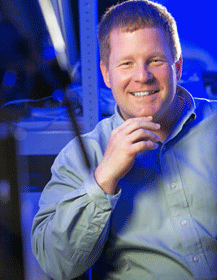By Tom Kurke, COO, Geomagic
Can you see them from where you are? If you can't see them yet, you certainly will.
We have two incredibly interesting mega trends which are currently impacting the technology space that my company, Geomagic plays in. Both involve the democratization of technology - moving from limited, high cost, low volume markets to further up the technology adoption curve.
 On the one hand we have an explosion of low cost reality capture devices, from the consumer space (like the Microsoft® Kinect) into the medium range terrestrial laser scanning space (with the industry-shifting Faro FOCUS 3D scanner). On the other hand we have the explosion of consumer and"value" oriented additive manufacturing, or 3D printing, devices - like those offered by 3D Systems (with their new Cubify hardware offering), Makerbot Industries and others. In the middle are several data transformation, transmission and other value added services to get the captured 3D content out to a printer (like Thingiverse, Ponoko, iMaterialise, Google Warehouse, Shapeways and Cubify). I refer to this space as the"Capture, Modify, Make" Ecosystem.
On the one hand we have an explosion of low cost reality capture devices, from the consumer space (like the Microsoft® Kinect) into the medium range terrestrial laser scanning space (with the industry-shifting Faro FOCUS 3D scanner). On the other hand we have the explosion of consumer and"value" oriented additive manufacturing, or 3D printing, devices - like those offered by 3D Systems (with their new Cubify hardware offering), Makerbot Industries and others. In the middle are several data transformation, transmission and other value added services to get the captured 3D content out to a printer (like Thingiverse, Ponoko, iMaterialise, Google Warehouse, Shapeways and Cubify). I refer to this space as the"Capture, Modify, Make" Ecosystem.
Gartner Research publishes a series of"Hype Cycle" charts which illustrate where (in their opinion) various technologies and technology trends are, in the adoption cycle. Technology, in their vernacular, goes from a Technology Trigger, through the Peak of Inflated Expectations, only to slide through the Trough of Disillusionment, to the Slope of Enlightenment, ending at the Plateau of Productivity. For more context here, this book on"Mastering the Hype Cycle" is useful context - http://www.gartner.com/it/products/research/media_products/book/
In June of 2011 Gartner evaluated 1900 different technologies, and concluded that 3D printing was cresting into the Peak of Inflated Expectations. http://www.gartner.com/it/page.jsp?id=1763814. (To see this very informative chart, visit: http://www.gartner.com/hc/images/215650_0001.gif)
Regardless of where or whether you believe that 3D printing is going to be"next big thing" and truly transformational with in-home 3D printing or"merely" limited to industrial production processes (even if, for example, as part of a service that allows for mass customization and drop shipment to your house) there are significant intellectual property issues that cut across the entire ecosystem.
Simply put, our existing laws (both statutory and common) will need to be stretched (in good and bad ways) to cover data capture, transformation and production. In many ways I believe we are entering into the next"Napster" era - where the legitimate rights of various stakeholders need to be balanced.
If you are thinking -"I don't see this at all" consider the story last week which broke that Pirate Bay, one of the largest file sharing networks in the world has created a new category of shareable assets called"Physibles" in which users can trade models capable of being printed on 3D printers.
Of course services that allow for the distribution and remote printing of 3D content as STL files is not new by any measure (many of the services noted above facilitate this already). What most certainly is new is that a known site which facilitates piracy is promoting it. In their blog post titled"Evolution: New Category" (see: http://thepiratebay.org/blog/203) TPB blogs that:
We believe that the next step in copying will be made from digital form into physical form. It will be physical objects. Or as we decided to call them: Physibles. Data objects that are able (and feasible) to become physical. We believe that things like three dimensional printers, scanners and such are just the first step. We believe that in the nearby future you will print your spare sparts for your vehicles. You will download your sneakers within 20 years.
The benefit to society is huge. No more shipping huge amount of products around the world. No more shipping the broken products back. No more child labour. We'll be able to print food for hungry people. We'll be able to share not only a recipe, but the full meal. We'll be able to actually copy that floppy, if we needed one.
We believe that the future of sharing is about physible data. We're thinking of temporarily renaming ourselves to The Product Bay - but we had no graphical artist around to make a logo. In the future, we'll download one.
For more on Pirate Bay (also referred to as"TPB") see: http://en.wikipedia.org/wiki/The_Pirate_Bay. I also encourage you to read the recent story on The Daily at: http://www.thedaily.com/page/2012/01/25/012512-tech-3d-pirates-1-2/ ("Genuine Fakes - With the rise of 3D printers, new questions of piracy loom"
I know I see the storm clouds coming, and they are blowing right behind The Pirate Bay ship. . .
In this blog I will cover various topics that impact our industry. In the coming weeks and months I will walk through a primer on intellectual property law and how it intersects with the exciting Capture, Modify, Make ecosystem. If you have suggestions or criticisms, please reach out to me - I look hearing from you.